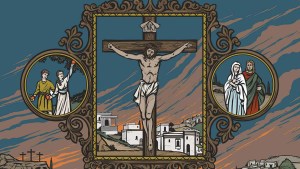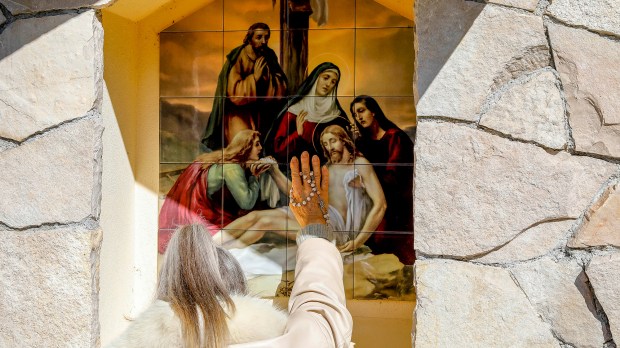Many Catholics are familiar with the traditional 14 Stations of the Cross that are displayed in almost every modern Catholic Church. Following the Way of the Cross by praying at each of these stations is a devotional practice that has been promoted by Franciscans since the 14th century.
The devotion also has roots in an ancient tradition that the Blessed Virgin Mary visited the sites of Jesus’ suffering, death and resurrection on a daily basis after his ascension into Heaven. Many other traditions also claim that Mary followed Jesus as he took his cross to Calvary.
Regardless of how this devotion developed, there is no “right” way to pray the Stations, and this devotion has been interpreted in a variety of ways over the centuries.
Here is a list of 8 different ways to pray the Stations of the Cross devotion. Please click on the links below to view instructions on each alternative
- The Seven Falls of Christ
The number of stations was not fixed at 14 until the 18th century, and prior to that one popular rendition put the number at seven. The number seven is a very biblical and in the Christian tradition has always been thought as the number of “perfection.” Similarly, there is the ancient devotion of the “Seven Sorrows of Mary,” which focuses on sorrowful events in Mary’s life, such as the Passion of her son, Jesus. As a result, it’s not surprising that early versions of the stations would keep the number at seven. In particular, this devotion was popular in Germany where, according to the Catholic Encyclopedia, “Those at Nuremburg, which were carved by Adam Krafft [in 1490], as well as some of the others, consisted of seven Stations, popularly known as ‘the Seven Falls,’ because in each of them Christ was represented either as actually prostrate or as sinking under the weight of His cross.” - A Marian alternative to the Stations of the Cross
Franciscans popularized the practice with their Stations of the Cross, but that is not the only way of walking in the sorrowful footsteps of Mary. There also developed a devotion called the Via Matris (“Way of the Mother”), which focuses on the seven sorrows of Mary — not only at the crucifixion, but also throughout her life. According to the Sisters of Our Lady of Sorrows, “Modeled on the Via Crucis, the pious exercise of the Via Matris Dolorosae, or simply the Via Matris, developed and was subsequently approved by the Apostolic See. This pious exercise already existed in embryonic form since the sixteenth century, while its present form dates from the 19th century.” - How to pray the Stations of the Cross as if you were there
The imagination is extremely important in prayer. You could say that God imagined the world into existence. He imagined the earth and the sky and you and me. Our imagination hence is a gift God has given us to be true co-creators, so that we can imagine a world through him. St. Ignatius taught that the imagination was vital for prayer because it’s a way of expressing our heads and our hearts, which are divinely connected to God. Just imagine for a moment the Sign of the Cross and see how when we intone the Father and the Son we are connecting the head and the heart. You could say that the imagination is the product of that relationship. Specifically, the imagination joins us with Jesus when we use that gift in meditating on something like the Stations of the Cross. - Pray the Stations of the Cross with these beautiful images and prayers
One of the most powerful ways to enter into the Passion and death of Jesus is to pray the pious devotion known as the “Stations of the Cross.” In 1342 the Franciscans were appointed special guardians of the sacred sites in the Holy Land, and soon they started erecting outdoor shrines, known as “stations,” that replicated these sites. It allowed people who could not make a pilgrimage to the Holy Land the opportunity to meditate on these powerful scenes wherever they were.Over the years various sculptures and paintings were made to make it even easier for people to contemplate the many mysteries of Good Friday - A very short Way of the Cross
One option is a method reportedly used by Franciscan friars when they went out on missions. Franciscans have always had a close link to the Way of the Cross. as they have had a constant presence in the Holy Land since the 14th century.Their short Way of the Cross can be prayed in about 5 minutes, depending on how long you meditate on each station. - Stations of the Cross for busy people
Praying the Stations doesn’t have to be a grandiose orchestration in order to receive the many graces of accompanying Jesus on his way to Calvary. It can be very simple and take less than 10 minutes. If you find yourself overwhelmed with little time to devote to prayer, consider this simplified option of praying the Stations that you can easily pray whenever and wherever you are able.These simplified Stations are adapted from a version composed by St. Alphonsus Liguori in 1787. - A Sinner’s Stations of the Cross
Pope Francis has said that the most damaging characteristic of our world is that it has lost the sense of sin. What better way to remember the horror of sin and the beauty of conversion than to meditate on the Passion of Jesus, who died for our sins? Here are Way of the Cross meditations on the tragedy of sin in each life. - Pray the Stations with St. Joseph
What about experiencing the Stations of the Cross with St. Joseph? Maybe that seems out of place. Joseph was not at Calvary. He did not experience the Passion alongside Jesus. Yet, I believe we can parallel the life of the Holy Family to that of the Stations of the Cross and ask the intercession of St. Joseph in this traditional Lenten devotion. Connections can be made and drawn, making the life of St. Joseph worthy of our meditation and also helping us to connect the lives of Joseph and Jesus with Christ’s ultimate sacrificial and redemptive act.

Read more:
A new Stations of the Cross book for kids of all ages

